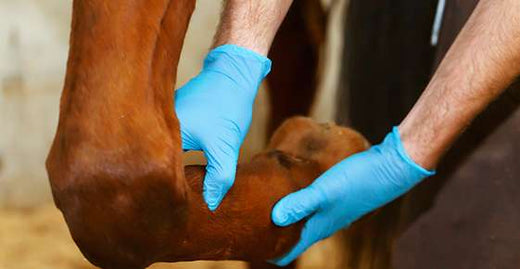
The Top 5 Most Common Injuries in Horses in South Africa
Share
Caring for horses in your own stable comes with its joys and challenges. One of the most significant responsibilities for any horse owner is ensuring their animals remain injury-free and recover swiftly when accidents happen. Below, we have listed the five most common injuries affecting horses in South Africa, how they occur, recovery time, healing aids, and preventative measures.
Hoof Abscesses
How Common?
Extremely common, particularly during the wet summer months in South Africa when muddy conditions prevail.
How It Happens:
Hoof abscesses typically occur when bacteria enter through small cracks, bruises, or punctures in the hoof. Wet conditions can soften the hoof, making it more vulnerable to infection.
Healing Time:
With proper care, abscesses can resolve in 7–14 days.
How to Aid Healing:
- Clean the hoof and apply a poultice to draw out the infection.
- Regularly soak the hoof in warm Epsom salt water to reduce inflammation.
- Supplement the horse's diet with Slent Gold Equestrian Omega Oil, as its anti-inflammatory properties can help the horse recover faster and maintain healthy hooves.
How to Avoid It:
- Regular hoof maintenance and cleaning.
- Provide a dry area where horses can stand during wet conditions.
- Feed a balanced diet enriched with omega oils to strengthen hoof quality.
Tendon and Ligament Strains
How Common?
Moderately common, especially in horses used for riding or show jumping.
How It Happens:
Overexertion or improper footing during exercise can lead to strains in tendons and ligaments, particularly in the legs.
Healing Time:
Recovery can take anywhere from 6 weeks to 6 months, depending on the severity.
How to Aid Healing:
- Rest is essential; limit the horse’s movement.
- Apply cold therapy to reduce initial swelling, followed by heat therapy to promote circulation.
- Incorporate Slent Gold Equestrian Omega Oil into their feed to support tissue repair and reduce inflammation naturally.
How to Avoid It:
- Gradually increase exercise intensity.
- Ensure riding surfaces are even and well-maintained.
- Regularly check and maintain the horse’s weight to reduce strain on its legs.
Colic
How Common?
A leading cause of veterinary emergencies in South African horses.
How It Happens:
Colic can occur from various factors, such as sudden dietary changes, dehydration, or eating mouldy feed.
Healing Time:
Mild cases may resolve in a few hours, while severe cases require immediate veterinary intervention and can take weeks to fully recover.
How to Aid Healing:
- Provide immediate veterinary care.
- Feed smaller, more frequent meals.
- Supplement with Slent Gold Equestrian Omega Oil, which helps improve digestion and supports a healthy gut.
How to Avoid It:
- Maintain a consistent feeding schedule with high-quality forage.
- Always provide fresh, clean water.
- Introduce dietary changes gradually.
Scratches and Skin Irritations
How Common?
Very common, particularly during the summer when insects and UV exposure are at their peak.
How It Happens:
These irritations often occur due to insect bites, sweat buildup, or rubbing against rough surfaces.
Healing Time:
Minor scratches heal within a week, while more severe irritations may take several weeks.
How to Aid Healing:
- Clean the affected area daily and apply an antiseptic.
- Incorporate Slent Gold Equestrian Omega Oil into the diet to promote skin repair and maintain a healthy coat.
How to Avoid It:
- Use fly sprays and protective gear, such as fly sheets.
- Keep stable environments clean and free of debris.
- Bathe the horse regularly during the summer.
Back and Saddle Sores
How Common?
Quite common in horses ridden regularly, especially if tack is ill-fitting or improperly maintained.
How It Happens:
Back and saddle sores develop due to prolonged pressure or friction from poorly fitted saddles or unbalanced riders.
Healing Time:
Minor sores can heal in a few weeks, but severe cases may take months.
How to Aid Healing:
- Allow the horse to rest and avoid riding until the sores heal.
- Clean the sores with mild antiseptic and keep the area dry.
- Add Slent Gold Equestrian Omega Oil to their diet to support faster recovery and maintain coat health.
How to Avoid It:
- Ensure saddles and tack fit correctly.
- Use quality saddle pads and regularly check for wear.
- Maintain your horse’s fitness to support a strong, balanced posture during rides.
The health and well-being of your horse should always be a top priority. By understanding common injuries and taking preventative measures, you can ensure your horse remains happy and healthy. Remember, proper nutrition plays a significant role in both preventing injuries and aiding recovery. Adding Slent Gold Equestrian Omega Oil to your horse’s diet is a simple yet effective way to promote overall health, reduce inflammation, and support recovery from injuries.
If you have any questions or want to learn more about incorporating Slent Gold into your horse’s diet, feel free to reach out. Your horse deserves the best!
or buy SLENT GOLD Equestrian Omage Supplement on Makro here: https://www.makro.co.za/search/?q=%3Arelevance%3Abrand%3ASlent%20Gold
